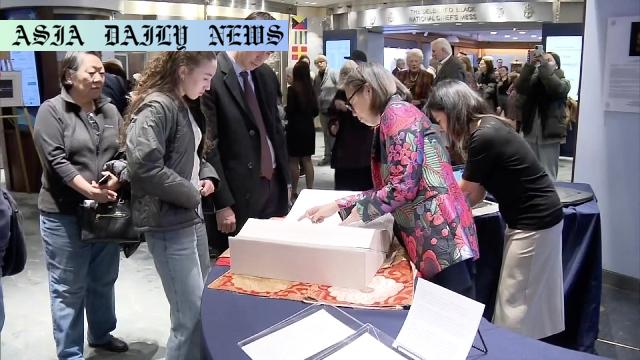Incarceration: A book listing 125,000 Japanese Americans sent to WWII internment camps will tour the US for public education.
The book honors 125,000 Japanese Americans sent to WWII internment camps.
It will be displayed in Washington and tour eight states by July 2024.
The initiative aims to educate about the injustice and resilience of Japanese Americans.
The Japanese American National Museum in Los Angeles houses the original book.

The Legacy of Incarceration
During World War II, over 125,000 Japanese Americans were forcibly relocated and imprisoned in internment camps following Executive Order 9066. Signed by then-President Franklin D. Roosevelt on February 19, 1942, the order classified individuals of Japanese ancestry as “hostile aliens,” leading to one of the darkest chapters of American history. Today, efforts to commemorate and educate the public about this grave injustice include a traveling exhibit featuring a book listing the names of those affected.
The Ambitious Nationwide Tour
The book, normally housed at the Japanese American National Museum in Los Angeles, serves as a testament to the resilience and struggles of the Japanese American community. It began its tour in Washington, D.C., and will be showcased across eight states by July 2024, visiting areas where internment camps were historically located. This effort aims to bring the forgotten stories of hardship and perseverance to the forefront of public consciousness, ensuring that this chapter of history is neither ignored nor repeated.
Voices from the Community
At the launch event in Washington, Ann Burroughs, President and CEO of the Japanese American National Museum, emphasized the timeliness of this exhibit. She called the incarceration of Japanese Americans a “warning of the consequences of failed leadership and justice.” Meanwhile, descendants of those impacted by the internment spoke of the importance of this initiative. A woman from Maryland, whose grandparents endured incarceration, expressed hope that the tour would educate people outside of Japanese descent about the struggles and resilience of the affected community.
A History Lesson for Future Generations
Beyond safeguarding the history of Japanese internment, the initiative seeks to educate future generations. The traveling exhibit acts as a visual and emotional reminder of why vigilance against prejudice and discrimination is essential. The historical value is further amplified by the personal stories and solidarity expressed during the ceremonies accompanying the book’s display. Educators, activists, and policymakers alike have been urged to treat this exhibit as a resource for advancing civil rights education.
The Broader Implications of Remembrance
Preserving history through this display is more than a retelling of past events; it is an active resistance against forgetting. The exhibit also highlights systemic failures of leadership and justice that allowed such large-scale discrimination to occur. By documenting these lessons, the Japanese American National Museum underscores how fragile civil liberties can be during times of national crisis. Visitors are encouraged to reflect on parallels between past and present injustices and take action to ensure a more equitable future.
Conclusion: A Tribute to Resilience
The traveling exhibit symbolizes both the pain endured and the resilience demonstrated by Japanese Americans during WWII. It calls attention to a crucial aspect of American history while inspiring meaningful discourse about race, justice, and equality. The widespread appeal of the initiative lies in its ability to educate and unite people of diverse backgrounds. The journey of the book is a poignant reminder that in acknowledging past mistakes, we can better strive for a future free from discrimination and injustice.



Commentary
The Importance of Acknowledging History
It is heartening to see an effort that commemorates one of the most overlooked injustices in American history. The nationwide tour of the book listing the names of Japanese Americans who endured internment during WWII is a powerful way to preserve the stories of their resilience and struggles. This level of acknowledgment helps ensure that such acts of injustice are not forgotten and serves as a solemn reminder of how easily civil liberties can be eroded in times of fear.
Connecting the Past with the Present
The relevance of this exhibit extends far beyond its historical significance. In today’s socio-political climate, where minority groups continue to face discrimination and marginalization, the lessons from this dark chapter of history remain deeply pertinent. The words of Ann Burroughs resonate powerfully — the incarceration of Japanese Americans is more than a historical episode; it is also a cautionary tale about the consequences of failing justice and leadership during crises.
Educating and Inspiring Change
This project is not only a form of remembrance but also a vital educational endeavor. Displaying the book across the country, particularly in states connected to the history of internment camps, ensures that more people gain insight into this tragic period. Creating awareness is the first step toward fostering empathy and understanding between communities, and I believe that initiatives like this can inspire positive conversations about equality, justice, and accountability.
Looking Ahead
Ultimately, this exhibit serves as a reminder that, as a society, we must remain vigilant against prejudice and discrimination in all forms. By honoring the Japanese American community’s resilience and bringing their experiences to light, we take a step closer to building a more compassionate and inclusive world. This tour is a testament to both the weight of history and the enduring power of remembrance in shaping a better future.